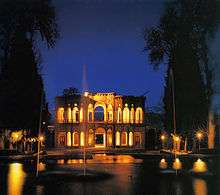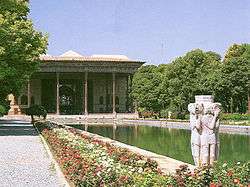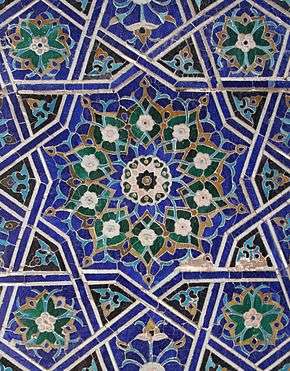Persian gardens
| The Persian Garden | |
|---|---|
| Name as inscribed on the World Heritage List | |
|
Chehel Sotoun's garden | |
| Type | Cultural |
| Criteria | i, ii, iii, iv, vi |
| Reference | 1372 |
| UNESCO region | Asia and Australasia |
| Inscription history | |
| Inscription | 2011 (35th Session) |
The tradition and style of garden design represented by Persian gardens or Iranian gardens (Persian باغ ایرانی) has influenced the design of gardens from Andalusia to India and beyond.[1][2] The gardens of the Alhambra show the influence of Persian garden philosophy and style in a Moorish palace scale, from the era of Al-Andalus in Spain. The Humayun's Tomb and Taj Mahal have some of the largest Persian gardens in the world, from the era of the Mughal Empire in India.
Concept and etymology



From the time of the Achaemenid Dynasty the idea of an earthly paradise spread through Persian literature and example to other cultures, both the Hellenistic gardens of the Seleucids and the Ptolemies in Alexandria. The Avestan word pairidaēza-, Old Persian *paridaida-,[note 1] Median *paridaiza- (walled-around, i.e., a walled garden), was borrowed into Ancient Greek: παράδεισος parádeisos, then rendered into the Latin paradīsus, and from there entered into European languages, e.g., French paradis, German Paradies, and English paradise. The word entered Semitic languages as well: Akkadian pardesu, Hebrew pardes, and Arabic firdaws.[3]
As the word expresses, such gardens would have been enclosed. The garden's purpose was, and is, to provide a place for protected relaxation in a variety of manners: spiritual, and leisurely (such as meetings with friends), essentially a paradise on earth. The Common Iranian word for "enclosed space" was *pari-daiza- (Avestan pairi-daēza-), a term that was adopted by Christian mythology to describe the garden of Eden or Paradise on earth.[4]
The garden's construction may be formal (with an emphasis on structure) or casual (with an emphasis on nature), following several simple design rules. This allows a maximization, in terms of function and emotion, of what may be done in the garden.
History

Persian gardens may originate as early as 4000 BCE.[5] Decorated pottery of that time displays the typical cross plan of the Persian garden. The outline of the Pasargad Garden, built around 500 BCE, is viewable today.
During the reign of the Sassanids (third to seventh century CE), and under the influence of Zoroastrianism, water in art grew increasingly important. This trend manifested itself in garden design, with greater emphasis on fountains and ponds in gardens.
During the Islamic occupation, the aesthetic aspect of the garden increased in importance, overtaking utility. During this time, aesthetic rules that govern the garden grew in importance. An example of this is the chahār bāgh (چهارباغ), a form of garden that attempts to emulate Eden, with four rivers and four quadrants that represent the world. The design sometimes extends one axis longer than the cross-axis, and may feature water channels that run through each of the four gardens and connect to a central pool.
The invasion of Persia by the Mongols in the thirteenth century led to a new emphasis on highly ornate structure in the garden. Examples of this include tree peonies and chrysanthemums. The Mongol empire then carried a Persian garden tradition to other parts of their empire (notably India).
Babur introduced the Persian garden to India. The now unkempt Aram Bāgh garden in Agra was the first of many Persian gardens he created. The Taj Mahal embodies the Persian concept of an ideal, paradise-like garden.
The Safavid Dynasty (seventeenth to eighteenth century) built and developed grand and epic layouts that went beyond a simple extension to a palace and became an integral aesthetic and functional part of it. In the following centuries, European garden design began to influence Persia, particularly the designs of France, and secondarily that of Russia and the United Kingdom. Western influences led to changes in the use of water and the species used in bedding.
Traditional forms and style are still applied in modern Iranian gardens. They also appear in historic sites, museums and affixed to the houses of the rich.
Elements of the Persian garden

Sunlight and its effects were an important factor of structural design in Persian gardens. Textures and shapes were specifically chosen by architects to harness the light.[6]
Iran's dry heat makes shade important in gardens, which would be nearly unusable without it. Trees and trellises largely feature as biotic shade; pavilions and walls are also structurally prominent in blocking the sun.
The heat also makes water important, both in the design and maintenance of the garden. Irrigation may be required, and may be provided via a form of underground tunnel called a qanat, that transports water from a local aquifer. Well-like structures then connect to the qanat, enabling the drawing of water. Alternatively, an animal-driven Persian well would draw water to the surface. Such wheel systems also moved water around surface water systems, such as those in the chahar bāgh style. Trees were often planted in a ditch called a juy, which prevented water evaporation and allowed the water quick access to the tree roots.
The Persian style often attempts to integrate indoors with outdoors through the connection of a surrounding garden with an inner courtyard. Designers often place architectural elements such as vaulted arches between the outer and interior areas to open up the divide between them.
Descriptions
An early description (from the first half of the fourth century BCE) of a Persian garden is found in Xenophon's Oeconomicus in which he has Socrates relate the story of the Spartan general Lysander's visit to the Persian prince Cyrus the Younger, who shows the Greek his "paradise at Sardis". In this story Lysander is "astonished at the beauty of the trees within, all planted at equal intervals, the long straight rows of waving branches, the perfect regularity, the rectangular symmetry of the whole, and the many sweet scents which hung about them as they paced the park"[7]
The oldest representational descriptions and illustrations of Persian gardens come from travelers who reached Iran from the west. These accounts include Ibn Battuta in the fourteenth century, Ruy Gonzáles de Clavijo in the fifteenth century and Engelbert Kaempfer in the seventeenth century. Battuta and Clavijo made only passing references to gardens and did not describe their design, but Kaempfer made careful drawings and converted them into detailed engravings after his return to Europe. They show chahar bāgh type gardens that featured an enclosing wall, rectangular pools, an internal network of canals, garden pavilions and lush planting. There are surviving examples of this garden type at Yazd (Dowlatabad) and at Kashan (Bāgh-e Fin). The location of the gardens Kaempfer illustrated in Isfahan can be identified.
Styles

The six primary styles of the Persian garden may be seen in the following table, which puts them in the context of their function and style. Gardens are not limited to a particular style, but often integrate different styles, or have areas with different functions and styles.
| Classical | Formal | Casual | |
| Public | Hayāt | Meidān | Park |
| Private | Hayāt | Chahār Bāgh | Bāgh |
Hayāt
Publicly, it is a classical Persian layout with heavy emphasis on aesthetics over function. Man-made structures in the garden are particularly important, with arches and pools (which may be used to bathe). The ground is often covered in gravel flagged with stone. Plantings are typically very simple - such as a line of trees, which also provide shade.
Privately, these gardens are often pool-centred and, again, structural. The pool serves as a focus and source of humidity for the surrounding atmosphere. There are few plants, often due to the limited water available in urban areas.
Meidān

This is a public, formal garden that puts more emphasis on the biotic element than the hayāt and that minimises structure. Plants range from trees, to shrubs, to bedding plants, to grasses. Again, there are elements such as a pool and gravel pathways which divide the lawn. When structures are used, they are often built, as in the case of pavilions, to provide shade.
Chahar Bāgh
These gardens are private and formal. The basic structure consists of four quadrants divided by waterways or pathways. Traditionally, the rich used such gardens in work-related functions (such as entertaining ambassadors). These gardens balance structure with greenery, with the plants often around the periphery of a pool and path based structure.
Park
Much like many other parks, the Persian park serves a casual public function with emphasis on plant life. They provide pathways and seating, but are otherwise usually limited in terms of structural elements. The purpose of such places is relaxation and socialisation.
Bāgh
Like the other casual garden, the park, bāgh emphasizes the natural and green aspect of the garden. Unlike the park it is a private area often affixed to houses and often consisting of lawns, trees, and ground plants. The waterways and pathways stand out less than in the more formal counterparts and are largely functional. The primary function of such areas is familial relaxation.
World Heritage Sites
- The Persian Gardens:
- Pasargad Persian Garden at Pasargadae, Iran
- Chehel Sotoun, Isfahan,Iran
- Fin Garden, Kashan, Iran
- Eram Garden, Shiraz, Iran
- Shazdeh Garden, Mahan, Kerman, Iran
- Dolatabad Garden, Yazd, Iran
- Abbasabad Garden, Abbasabad, Mazandaran, Iran
- Akbarieh Garden. South Khorasan Province, Iran
- Pahlevanpour Garden Iran[8]
- Taj Mahal, Agra, India
- Humayun's Tomb, New Delhi, India
- Shalimar Gardens, Lahore, Pakistan
- Generalife, Granada, Spain
See also
Notes
- ↑ Although the genuine Old Persian form must have been *paridaida-, Modern Persian palīz 'garden' from Middle Persian palēz presupposes a variant *pardaiza- (with syncope of -i-), which seems to be the cognate of *paridaida- from a different Iranian language (Avestan, Median or Parthian) borrowed into Persian still in an early period. See Proto-Iranian *paridaiźa-.
References
- ↑ "Was the Persian Garden at Pasargadae a model for the Garden of Eden?". About.com Education. Retrieved 2016-02-09.
- ↑ Centre, UNESCO World Heritage. "The Persian Garden - UNESCO World Heritage Centre". whc.unesco.org. Retrieved 2016-02-09.
- ↑ Fakour M., Achaemenid Gardens ; CAIS-Online - accessed Jan 15, 2007
- ↑ Persians: Masters of Empire, p 62, ISBN 0-8094-9104-4
- ↑ Khansari, Mehdi; Moghtader, M. R.; Yavari, Minouch (2003-12-31). The Persian Garden: Echoes of Paradise. Washington, DC: Mage Publishers. ISBN 9780934211758.
- ↑ "Pasargadae: The Persian Gardens | Kaveh Farrokh". kavehfarrokh.com. Retrieved 2016-02-09.
- ↑ Xenephon. "Oeconomicus". Gutenberg Press. Retrieved 11 June 2015.
- ↑ UNESCO official website
Further reading
- Rostami, Raheleh., Hasanuddin, Lamit., Khoshnava, S. Meysam., Rostami, Rasoul (2014). "The Role of Historical Persian Gardens on the Health Status of Contemporary Urban Residents". Journal of EcoHealth, 11 (3), 308-321.
- Rostami, Raheleh., Hasanuddin, Lamit., Khoshnava, S. Meysam., Rostami, Rasoul (2015).Sustainable Cities and the Contribution of Historical Urban Green Spaces: A Case Study of Historical Persian Gardens, Journal of Sustainability, 7, 13290-13316.
- Rostami, Raheleh., Hasanuddin, Lamit., Khoshnava, S. Meysam., Rostami, Rasoul (2015).Successful Public Places, A case Study of Historical Persian Gardens, Journal of Urban Forestry & Urban Greening, In Press, doi:10.1016/j.ufug.2015.08.011
- Rostami, Raheleh., Hasanuddin, Lamit., Khoshnava, S. Meysam., Rostami, Rasoul (2011). "Contribution of Historical Persian Gardens for Sustainable Urban and Environment: Lessons from Hot Arid Region of IRAN". American Transaction on Engineering and Applied Sciences 1(3), 281-294.
- Khonsari, Mehdi; Moghtader, M. Reza; Yavari, Minouch (1998). The Persian Garden: Echoes of Paradise. Mage Publishers. ISBN 0-934211-46-9.
- Multiple authors (2010). "Garden". Encyclopædia Iranica.
- Newton Wilber, D (1979). Persian Gardens and Garden Pavilions. Washington.
- Michel Conan, Dumbarton Oaks (2007). Middle East Garden Traditions: Unity and Diversity.
External links
| Wikimedia Commons has media related to Gardens in Iran. |
- Isfahan "Persian Garden Design" website. Retrieved 3 January 2012.
- Babur's Garden - video from the Asia Society, US
- Animated film inspired by the Persian Architecture
- Farnoush Tehrāni, The Meaning of the Persian Garden, in Persian, Jadid Online, 12 Novembre 2009.
- Farnoush Tehrāni, The Face of the Persian Garden, in Persian, 13 November 2009.




